April 24th, 2014 — 7:16pm
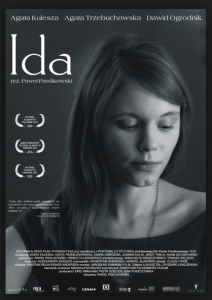 ***
***
Ida – sp We are pleased to report that for some unknown reason there are a number of readers of this blog who are from Poland. So we hope we will get some comments at the end of this review from them. This movie won The Eagle, which is the Polish equivalent of the American Oscar. It is in Polish with English subtitles. We understand it is also dubbed with the local language rather than using subtitles in many European countries, as it was in France, where is was a big hit. The setting is Poland in the 1960s. A young woman who is studying to be Nun in a convent is told by the Mother Superior that before she takes her vows she must go and meet her aunt, her only known family member (previously unknown to her) since she was brought to the convent as a baby during the war. She travels to the city where her aunt is located and finds out that she is Jewish. The two of them set off on a haunting road trip to find out what happened to her parents and where they are buried. The aunt, played by veteran Polish actress Aguta Lulesza, is tough as nails on the outside but has her own secret pain which is ripping her apart. Ida the novitiate, also known as Sister Anna Ida, and now with a last name Lebenstein, is played by a first time actress who was discovered in a coffee shop by the director. Her name is Agata Trzebuchowska. She is beautiful, and now burdened with a dilemma of what to do with her new insight into her origin. She also has to decide whether to go forward and take her vows, which of course includes chastity. It should be mentioned that on her road trip she does meet a handsome musician (David Ogrodnik) and we do detect some chemistry between them. The ambience of this film befits the subject matter. It is in black and white using a 4×3 format (almost square) with many close-ups. The locations are old bleak buildings, churches, a cemetery, and old roads with a lot of snow. The dialogue, although in Polish with subs, is sparse. There is a Polish 60s musical background that is mostly ambient rather than with a soundtrack. There are reminders of the role of communist rule in post war Poland. Everything is not spelled out for the viewer but there is little doubt about the story and the internal pain that our characters are feeling. It will awaken feelings about atrocities in WW II, which are still not far from the surface in many people, some now two generations removed from it. Although director and screenwriter Pawel Pawlikowski in a post film discussion said he had no doubt about how this 80 minutes film should end, there is another point of view on this subject. Finally, this movie is one of many films that have a theme which shows the immense struggle that people have to connect with a biological parent or vice versa. A discussion and summary of this issue can be found at http://www.psychiatrytalk.com/2014/04/the-search-for-a-persons-biological-identity/ (2014)
Comment » | 3 Stars, Drama, Foreign
April 17th, 2014 — 5:47pm
***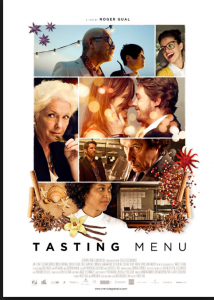
Tasting Menu- sp- This film is mostly in Catalan with some English and has English subtitles. It is an ensemble movie nicely blended together as a well-crafted meal. None of the characters or their stories is very heavy with details but they are combined into an absorbing tale, lightly sprinkled with some comedy and some touching emotional moments. Chef Mar Videl (Viventa N’dongo), who has won the award for the world’s best chef three times, has her world famous restaurant which only seats 30 on Spain’s Costa Brava with her partner Max (Andrew Tarbel). They have decided to close their restaurant and move on to other things but will serve one last sensational meal. One couple has a reservation there on the final night for over a year. However, they split up but neither wanted to give up their table so Rachel, (Claudia Bassols) a famous writer and Marc, a young prominent pediatrician, (Jan Cornet) do attend this last meal. So does Danny (Timothy Gibbons), Rachel’s editor and wannabe boyfriend who wangles a reservation to be in this select group. There is the Countess (Fionnula Flanagan) who in her healthier younger days would eat there many times with her illustrious husband who will attend this time in the form of his ashes in an urn. Two competing businessmen, ( Toto Igawa and Akihiko Serikawa) from Japan, who want to reopen the restaurant in their country are in attendance as is Mina (Marta Torne), their guide for their visit to the U.S. The final main character and perhaps the most mysterious and interesting of all is Walter (Stephen Rea) who we never quite figure out. Before we get to the dessert there is a boat lost at sea which includes the musicians who were to play that evening and this unlikely group might even try to save them. There is very little logic to this screenplay by Roger Gual who also directed it but the chances are you will come away satiated with a good feelings and delighted by its charm. (2014)
Comment » | 3 Stars, Comedy, Drama, Foreign
April 12th, 2014 — 10:44pm
***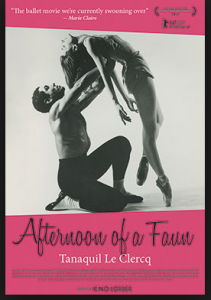
Afternoon of the Faun : Tanaquil Le Clercq rm- If you love ballet and are familiar with the great artists and choreographers  as well as the history of ballet you probably will very much enjoy this documentary film It is about a young girl who at age 14 was a talented student studying at a school run by the great Balanchine . Four years later she not only was dancing with him but soon after was married to him, although he was nearly 25 years her senior. Tanquil Le Clercq, known as “Tanny†had a long , lovely and distinctive physique. Her dancing not only inspired Balanchine but she was also said to be a muse for Jerome Robbins who created his famous Afternoon of a Faun for Tanny. She was one of the most famous dancers of her time until at the age of 27 she was struck down by polio, which was the plague of its time. This was a disease that unexpectedly would make its appearance and would especially  paralyze children and young adults. It could even be fatal. Salk’s amazing vaccine came on the scene a short time later. Tanny was forced to be in an “iron lung†which would help her breathe and then over several years graduated to a wheel chair from which she became a teacher of ballet. The film consists mostly of beautiful film clips of Tanny dancing with Balanchine and others. There are clips of people talking about this unusual woman and her life. Not only is there Balanchine and  Jerome Robbins, who was very close to her, but others such as Jacque D’Ambroise, Arthur Mitchell and a women who for many years was Balanchine’s secretary and assistant. Her insights, particularly into the thinking of her boss, captured some of the conflict that he must have had for loving and caring about Tanny, but pursuing his own career as he worked with other ballerinas, eventually leaving Tanny to marry another dancer. It is unfortunate that we never hear a meaningful interview with the main star of this film We come to care about her through the old movies of her performing her magnificent dancing and the glimpses of her beauty even in the later years. We also learn about her strength, intelligence and humor from excerpts of letters she wrote, which were read by an unseen actress in the film..  This all takes place  with the rich and melodic music of the ballet, which accompanies not only the dancing but also this moving story. If you don’t have a special relationship to ballet and dance this documentary film will probably not move you very much. But if you do, be prepared to be swept off your feet and be caught up in the true tale  of this beautiful and tragic person.(2014)
Comment » | 3 Stars, Documentary
April 11th, 2014 — 6:07am
**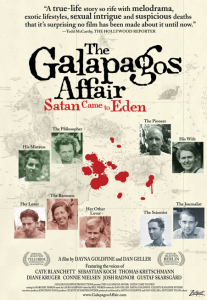
The Galapagos Affair- sp- This documentary film takes place on the Galapagos Islands which are a group of 19 small islands in the Pacific Ocean about 600 miles from the coast of Ecuador. In the early 1930s a handful of people decided they wanted to get away from civilization and live on one of most deserted and smaller islands of this group named Floreana Island. The first couple to settle there was a young physician from Berlin, Friedrick Ritter who was a student of the writings of the German philosopher Friedrich Nietzsche. He was accompanied by his girlfriend Dore Strauch who had multiple sclerosis but seemed quite fit as they both worked the land. They were joined on the island by Margaret and Heinz Wittmer who raised a family there. The other important people that we see on the island are the so-called Baroness Eloise von Wagner who is flamboyant woman who settles there with her two lovers with the plan to build a hotel. All of the inhabitants are mostly off to themselves but occasionally interact as for example when Dr. Ritter delivers one of the Wittmer’s children. There are occasional brief visits by various ships, which included scientists and naturalists who studied the beautiful natural vegetation and wildlife on the island. Although not discussed in the film one of these visitors was Captain Alan Hancock, a wealthy philanthropist who financed research expeditions to the Galapagos Islands. He also was an early user of 8mm movie film and he photographed the inhabitants of the island doing various activities over a period of a few years. He also photographed a fictionalized short silent film starring the Baroness titled the Empress of Floreana. It was the availability of these archived movie footage that allowed filmmakers Daniel Geller and Dayna Goldfine to put together this documentary film. They chose to present this film as an unsolved mystery since there were two unexplained disappearances and one death under unusual circumstances. It appeared that most of the people on the island were writers of sorts and many recorded their day-to-day observations and feelings Therefore the screenplay written by Geller and Goldfine included dialogue written by the various inhabitants. This was read by actors and actress while we mostly watched the old movies that have been dug out from the archives and skillfully weaved to match the dialogue or vice versa. This included the voices of  Cate Blanchett as Dore Strauch, Thomas Kretschmann as Dr. Ritter, Sebastain Koch as Mr. Wittmer, Diane Kruger as Margret Wittmer and Connie Nielsen as the Baroness. Josh Radnor and Gustav Skarsgard were the voices of the two men in the Baroness’ life. There were too many details put out for us to digest and not enough focus on the individual characters for us to care very much about them. There were also too many additional contemporary interviews with the children and relatives as well as with some surviving main characters. We never got a good feel for the murder mystery, which they were trying to unfold. This was despite taking two hours to play out the movie. Perhaps this is a film that you might want to see prior to a tourist trip to these islands but it is not one we can recommend for your movie entertainment. (2014)
Comment » | 2 Stars, Documentary, Mystery
April 5th, 2014 — 6:25am
***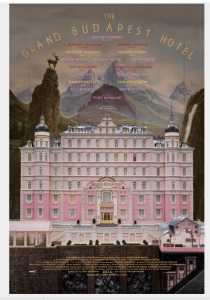
The Grand Budapest Hotel- rm–  This movie is a mixture of a fairytale, a romp with the keystone cops and a sophisticated mystery.  We are introduced to the Grand Budapest Hotel somewhere in Europe in modern times during an off-season. It is clear that the hotel has an interesting history, as does the one of main characters who we meet. That is an older Mr. Mustafa (F. Murray Abraham) now the owner of this Grand Lady of a Hotel that still is magnificent. He takes us back to what are probably the 1930;s when he was a young lobby boy of the hotel known as Zero (Tony Revolori). He became a protégé of Mr. Gustave (Ralph Fiennes) the legendary concierge of the hotel with whom he is about embark upon a great adventure. Gustave is the perfect gentleman who befriends the wealthy men and women who come to hotel. One in particular Madame D. (Tilda Swinton) leaves a valuable painting to him, which he discovers when he travels to pay his respects after she is murdered. His young faithful companion accompanies him. Their adventure leads to confrontation with police, soldiers, and time in jail with an escape, a bad villain and a fanciful tale. It all probably should viewed as an allegory for the good times of pre World War II in Europe that were turned into death and destruction with precious memories by those who survived. The director and screen writer Wes Anderson is known for bringing imaginative story lines to the screen such as Moonrise Kingdom, The Royal Tenenbaums, Rushmore and many others. In this case he based the story on writings of Stephen Zweig. The dialogue is fitting the upper crust that is being served by the likes of Gustave and his lobby boy but then periodically breaks down into paradoxical comments that bring out a good laugh and reminds you that there is satire going on here. The setting is old Europe and it was filmed in Germany where Anderson and his crew found or created not only the Grand Hotel but also magnificent castle like mansions, prisons and even escape tunnels. The cast was excellent which included Jude Law, Bill Murray, Ed Norton, Jeff Goldblum, Owen Wilson, Jason Swartzman, William DeFoe, Adrian Brody, Bob Balahan and others. Some had very small parts but all were on the mark to give a realistic performance in a fantasy movie. (2014)
Comment » | 3 Stars, Comedy, Drama, Mystery
 ***
***






